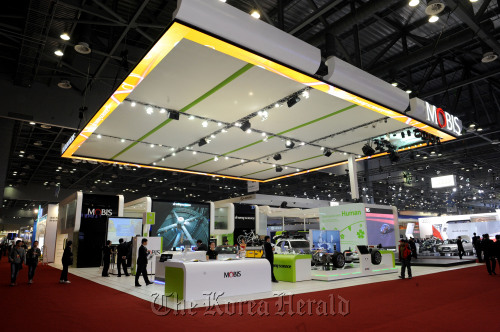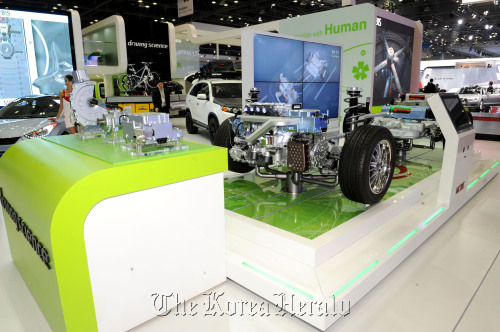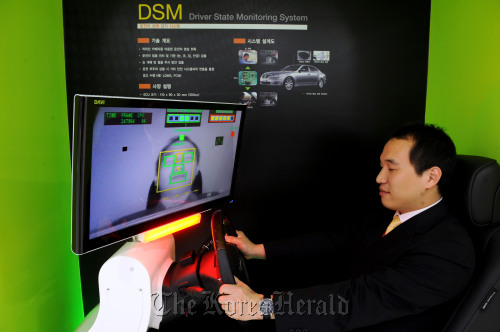Hyundai Mobis focuses on technology, environment, human values
By 최희석Published : April 6, 2011 - 19:59
Latest products from Korea’s top auto parts maker turn heads at Seoul Motor Show
Hyundai Mobis Co., South Korea’s largest automobile parts manufacturer, is grabbing the limelight at the Seoul Motor Show with its latest products emphasizing environmental and human values as well as technological edge.
The event is underway at the KINTEX exhibition center in Goyang, Gyeonggi Province on the largest scale to date under the theme “Evolution, Green Revolution on Wheels.”
While the show’s main attractions are carmakers’ exhibits, local and foreign automobile parts manufacturers are also taking the opportunity to show off their latest products and technologies.
Of 46 components makers participating in the exposition, Hyundai Mobis has set up the biggest booth, designed according to the three concepts of “beyond technology,” “save the earth” and “communion with human” that represent its underlying management philosophy.
“Under these three concepts, the company is using the show to highlight eco-friendly and smart automotive technologies,” a public relations official said.
In its drive for a spot among the world’s top 10 auto parts makers, Hyundai Mobis has been directing increasing resources to research and development in recent years.
Of the company’s 1.15 trillion-won ($1.06 billion) investment budget set for this year, 360 billion won will be injected into research and development for high-tech systems.
In doing so, the company plans to diversify its R&D personnel to include more engineers specializing in information technology, software, electronic engineering and mechatronics. The company is also planning to build a new R&D facility by 2012 equipped with a testing system for the majority of its automotive components.
Hyundai Mobis Co., South Korea’s largest automobile parts manufacturer, is grabbing the limelight at the Seoul Motor Show with its latest products emphasizing environmental and human values as well as technological edge.
The event is underway at the KINTEX exhibition center in Goyang, Gyeonggi Province on the largest scale to date under the theme “Evolution, Green Revolution on Wheels.”
While the show’s main attractions are carmakers’ exhibits, local and foreign automobile parts manufacturers are also taking the opportunity to show off their latest products and technologies.
Of 46 components makers participating in the exposition, Hyundai Mobis has set up the biggest booth, designed according to the three concepts of “beyond technology,” “save the earth” and “communion with human” that represent its underlying management philosophy.
“Under these three concepts, the company is using the show to highlight eco-friendly and smart automotive technologies,” a public relations official said.
In its drive for a spot among the world’s top 10 auto parts makers, Hyundai Mobis has been directing increasing resources to research and development in recent years.
Of the company’s 1.15 trillion-won ($1.06 billion) investment budget set for this year, 360 billion won will be injected into research and development for high-tech systems.
In doing so, the company plans to diversify its R&D personnel to include more engineers specializing in information technology, software, electronic engineering and mechatronics. The company is also planning to build a new R&D facility by 2012 equipped with a testing system for the majority of its automotive components.

Hyundai Mobis’ booth is divided into four sections.
The “driving innovation” partition includes displays designed to show and explain the company’s advanced technologies and equipment, and to allow visitors to experience some of those technologies first hand.
Exhibits in the section include a structure designed to show the workings of a hybrid electric vehicle’s powertrain and a simulator for lane-keeping assist system and the pre-crash safety system.

The lane-keeping assist system uses sensors to detect road markings to alert the driver if the vehicle changes lanes without the driver’s knowledge, while the pre-crash safety system engages the brakes automatically when obstacles are detected within the range of sensors.
The zone also includes a simulator equipped with around-view-monitor to allow visitors to experience using the company’s parking assist system that uses cameras and ultrasonic sensors to aid drivers in parking vehicles.
The “green driving” section of the exhibit is dedicated to the company’s energy-saving products including the intelligent battery sensor and active air flap.
“The intelligent battery sensor monitors the battery to minimize energy loss, extending the battery’s durability and helps to reduce a vehicle’s fuel consumption,” a Hyundai Mobis official said adding that the system is currently being supplied to the German luxury specialist Mercedes-Benz.
“The active air flap, shown in Korea for the first time, automatically opens or closes according to the temperature in the engine room and driving conditions with the result of improving a vehicle’s efficiency in heating and fuel consumption by 5 percent and 3 percent, respectively.”
In addition, the company is also displaying the “in-wheel” system in which each of the four wheels is fitted with an electric motor, enabling each wheel to move or brake independently.
While the company has made significant progress in developing eco-friendly automobile technologies concerning the powertrain, Hyundai Mobis has also been looking into areas that may at first appear to have little to do with making automobiles more environmentally friendly.
One example is the loudspeaker for onboard sound systems made from hanji, paper made using mulberry trees developed at the end of last year.
The diaphragm of the speakers is made with hanji surrounded with silicone rubber, the company said. According to the company, the use of such materials offers increased durability and helps reduce pollutants created when the loudspeakers are discarded.
“The “driving technology” zone of the booth displays some of the latest technologies in safety and convenience,” a Hyundai Mobis official said.
The zone also includes a simulator equipped with around-view-monitor to allow visitors to experience using the company’s parking assist system that uses cameras and ultrasonic sensors to aid drivers in parking vehicles.
The “green driving” section of the exhibit is dedicated to the company’s energy-saving products including the intelligent battery sensor and active air flap.
“The intelligent battery sensor monitors the battery to minimize energy loss, extending the battery’s durability and helps to reduce a vehicle’s fuel consumption,” a Hyundai Mobis official said adding that the system is currently being supplied to the German luxury specialist Mercedes-Benz.
“The active air flap, shown in Korea for the first time, automatically opens or closes according to the temperature in the engine room and driving conditions with the result of improving a vehicle’s efficiency in heating and fuel consumption by 5 percent and 3 percent, respectively.”
In addition, the company is also displaying the “in-wheel” system in which each of the four wheels is fitted with an electric motor, enabling each wheel to move or brake independently.
While the company has made significant progress in developing eco-friendly automobile technologies concerning the powertrain, Hyundai Mobis has also been looking into areas that may at first appear to have little to do with making automobiles more environmentally friendly.
One example is the loudspeaker for onboard sound systems made from hanji, paper made using mulberry trees developed at the end of last year.
The diaphragm of the speakers is made with hanji surrounded with silicone rubber, the company said. According to the company, the use of such materials offers increased durability and helps reduce pollutants created when the loudspeakers are discarded.
“The “driving technology” zone of the booth displays some of the latest technologies in safety and convenience,” a Hyundai Mobis official said.

“Displays include a driven-state monitoring system simulator, which alerts the driver using vibrations and warning lights if the driver closes his eyes for more than a certain period or if the driver is not concentrating on the road.”
Other displays in the zone include the brake-by-wire system that allows the brakes on each wheel operated separately using an electrical system instead of the conventional system that uses pressurized oil to control the brakes.
The last zone, which is designed under the concept “human driving,” is dedicated not to technologies but to products drivers can add on to vehicles.
“At the zone, customized Kia Sorento and Hyundai Avante are on display along with various items related to vehicle-care and customizing,” the Hyundai Mobis official said.
“Different kinds of tuning equipment are also on show including body-kits and visitors can also see for themselves the effectiveness of heat-blocking window films.”
By Choi He-suk (cheesuk@heraldcorp.com)
Other displays in the zone include the brake-by-wire system that allows the brakes on each wheel operated separately using an electrical system instead of the conventional system that uses pressurized oil to control the brakes.
The last zone, which is designed under the concept “human driving,” is dedicated not to technologies but to products drivers can add on to vehicles.
“At the zone, customized Kia Sorento and Hyundai Avante are on display along with various items related to vehicle-care and customizing,” the Hyundai Mobis official said.
“Different kinds of tuning equipment are also on show including body-kits and visitors can also see for themselves the effectiveness of heat-blocking window films.”
By Choi He-suk (cheesuk@heraldcorp.com)








![[Kim Seong-kon] Democracy and the future of South Korea](http://res.heraldm.com/phpwas/restmb_idxmake.php?idx=644&simg=/content/image/2024/04/16/20240416050802_0.jpg&u=)







![[KH Explains] Hyundai's full hybrid edge to pay off amid slow transition to pure EVs](http://res.heraldm.com/phpwas/restmb_idxmake.php?idx=652&simg=/content/image/2024/04/18/20240418050645_0.jpg&u=20240418181020)

![[Today’s K-pop] Zico drops snippet of collaboration with Jennie](http://res.heraldm.com/phpwas/restmb_idxmake.php?idx=642&simg=/content/image/2024/04/18/20240418050702_0.jpg&u=)